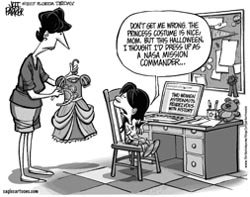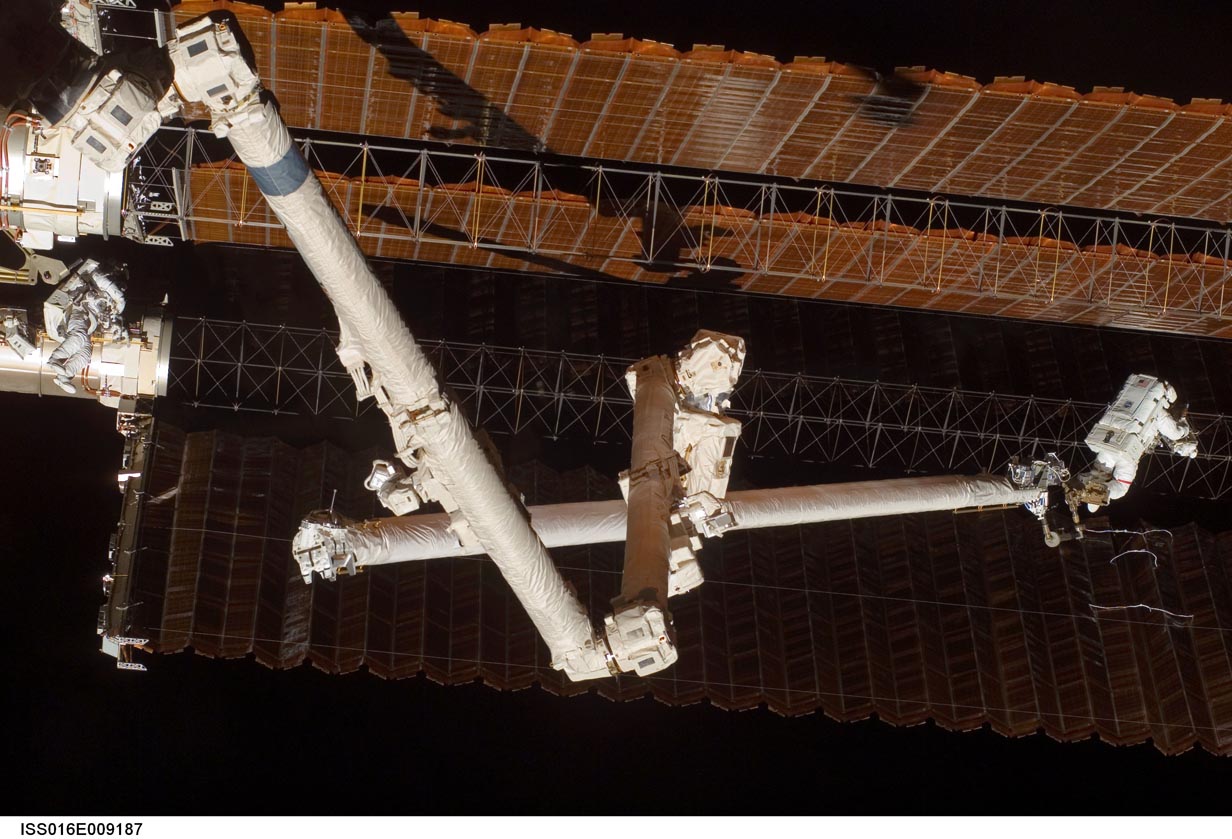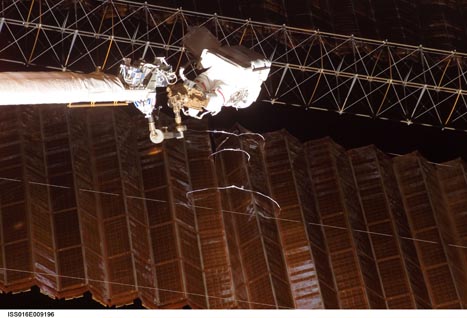STS-120 Docking
Last week, I was in Los Angeles and spoke at the Transforming Space 2007 conference organized by the California Space Authority. The portion of my speech that I believe garnered the greatest positive feedback was my discussion of the most recent Space Shuttle mission, STS-120, which landed on Wednesday, November 7.
The docking of STS-120 with the International Space Station (ISS) marked an historic event as ISS Commander Peggy Whitson and Shuttle Commander Pam Melroy greeted each other as the hatch was opened. This was the first time we’ve had female commanders on duty at the same time, and it attracted a lot of attention. I loved this cartoon that Lynn Cline, NASA Deputy Associate Administrator, Space Operations Mission Directorate, sent to me (cartoon by Jeff Parker, Florida Today, 2007):
 This Space Shuttle mission to the ISS clearly demonstrated the challenges of living and working in space, as well as using human ingenuity to deal with such challenges. The Shuttle and Station programs involve careful choreography of both crew activities, including spacewalks, and robotics tasks. In addition to the on-orbit teamwork between humans and machines, the interaction with the team on the ground that responds to emerging issues is essential. Finally, it is a partnership across nations. The recent mission involved crew from the United States, Russia and Europe, all working to achieve common goals.
This Space Shuttle mission to the ISS clearly demonstrated the challenges of living and working in space, as well as using human ingenuity to deal with such challenges. The Shuttle and Station programs involve careful choreography of both crew activities, including spacewalks, and robotics tasks. In addition to the on-orbit teamwork between humans and machines, the interaction with the team on the ground that responds to emerging issues is essential. Finally, it is a partnership across nations. The recent mission involved crew from the United States, Russia and Europe, all working to achieve common goals.
A key task of the STS-120 mission launched on October 23 was to move this array to its final location and then redeploy the array. The tasks to disconnect, move, and reattach the system all went well. However, when the attempt was made to unfold the array, the crew noticed some movement in the array and then saw a tear in it. The sun angle and camera views made it hard to detect the problem initially, but the crew stopped the deployment as soon as they saw it.
Here’s where the ingenuity comes in to play. The crew used the cameras and robot arms to get photos of the damaged area and described what they saw to the ground. The ground team went to work and in a matter of days, designed a repair and instructions for the crew. The planning for the spacewalk required creativity and “MacGuyver-like” skills (but no chewing gum). Astronauts on the Station cut aluminum strips and taped them together to form home-made braces, known as “cufflinks.” During the development of the techniques for the spacewalk, the team came up with a couple of tools that thought would be extremely useful and did not previously exist. Within hours, the Russians were able to get their spacewalk group together and devise a couple of them, and made Russian Station member Yuri Malenchenko available to help the U.S. crew out. In addition to adding these braces, it became clear that the guide wire would probably have to be cut since it seemed to be what caused the array panels to hang up and get torn.
 The team determined it would be better for our Astronaut to go to the damaged site rather than retracting the array to bring it closer to the truss. That meant a novel approach to reach the work site was needed. The Station robotic arm was used to hold a boom normally used with the Shuttle robotic system, and Astronaut Scott Parazynski, with Doug Wheelock also on the spacewalk to “spot” him, rode on the end of it. Once there, Parazynski carefully threaded each end of the brace through a grommet hole in the array. Five of these ‘cuff-links’ helped firm up the damaged panel. In addition, he discovered that the guide wire had frayed a good deal — he colorfully described it as a
The team determined it would be better for our Astronaut to go to the damaged site rather than retracting the array to bring it closer to the truss. That meant a novel approach to reach the work site was needed. The Station robotic arm was used to hold a boom normally used with the Shuttle robotic system, and Astronaut Scott Parazynski, with Doug Wheelock also on the spacewalk to “spot” him, rode on the end of it. Once there, Parazynski carefully threaded each end of the brace through a grommet hole in the array. Five of these ‘cuff-links’ helped firm up the damaged panel. In addition, he discovered that the guide wire had frayed a good deal — he colorfully described it as a
‘hairball’. He successfully cut the wire, which was not needed for structural integrity. Once these repairs were completed and Parazynski was backed away from the array, the Station crew was able to successfully and fully deploy the array robotically.
 (3 Nov. 2007) — While anchored to a foot restraint on the end of the STS-120 mission specialist, assesses his repair work as the solar array is fully deployed during the mission’s fourth session of extravehicular activity (EVA) while Space Shuttle Discovery is docked with the International Space Station. During the 7-hour, 19-minute spacewalk, Parazynski cut a snagged wire and installed homemade stabilizers designed to strengthen the damaged solar array’s structure and stability in the vicinity of the damage. Astronaut Doug Wheelock (out of frame), mission specialist, assisted from the truss by keeping an eye on the distance between Parazynski and the array.
(3 Nov. 2007) — While anchored to a foot restraint on the end of the STS-120 mission specialist, assesses his repair work as the solar array is fully deployed during the mission’s fourth session of extravehicular activity (EVA) while Space Shuttle Discovery is docked with the International Space Station. During the 7-hour, 19-minute spacewalk, Parazynski cut a snagged wire and installed homemade stabilizers designed to strengthen the damaged solar array’s structure and stability in the vicinity of the damage. Astronaut Doug Wheelock (out of frame), mission specialist, assisted from the truss by keeping an eye on the distance between Parazynski and the array.
(3 Nov. 2007) — One of a series of images of a two-foot tear in solar array material downlinked by the STS-120 crewmembers just a few hours prior to a two-person spacewalk scheduled to make repairs to the damaged area. Discovery and International Space Station crewmembers have been rehearsing their respective roles in the spacewalk, in concert with personnel on the ground.


For additional photos on STS-120 EVA and Flight Day photos, go to www.NASA.gov photo gallery
This is a great example of the value of humans in space. The ability to react real-time to new developments, to observe and describe what they see, and even to build new tools on the fly were demonstrated. The repair involved teamwork across the Shuttle and Station teams, between the ground and the on-orbit crew, across cultures, and between humans and robotic systems. When we return to the Moon, or journey to Mars, we’ll be even further from the Earth, and our crews will need to be able to improvise and deal with operational issues as they arise. We’ll be using integrated systems that are both automated and involving humans in the loop. While we’d prefer that everything goes according to plan without any glitches, that’s not realistic, so we need to be prepared to meet those challenges. It’s all part of exploration for the future and exploration that we’re doing right now.
